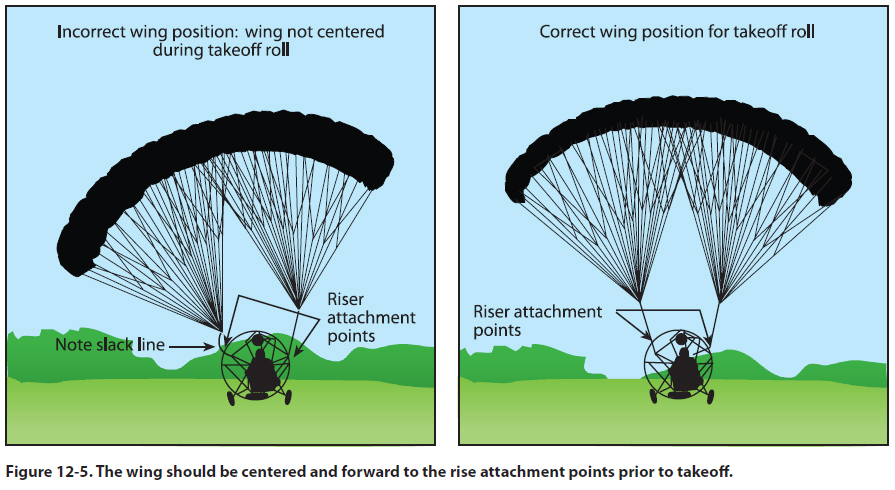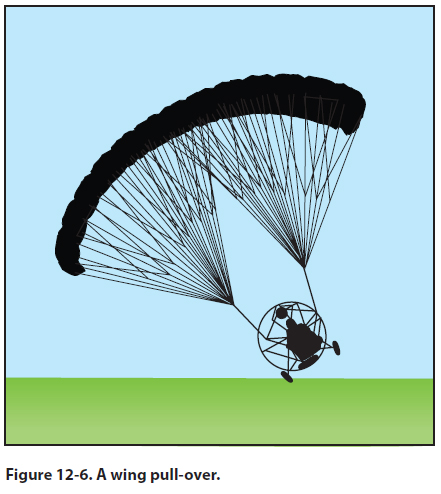|
Chapter 12 — Night, Abnormal, and Emergency Procedures
Wing Not Centered Overhead
No takeoff should ever be attempted until the wing
is centered above the cart and forward to the riser attachment
points.
[Figure 12-5]

Hence, if the wing is not centered when it comes
ahead to the riser attachment of the cart:
1. Keep steering into the wind, and
2. Keep your groundspeed below airborne (liftoff)
speed.
The most noteworthy aspect of the takeoff preflight
roll is to verify that the wing is positioned correctly.
Due to the design, the wing will normally want to
be up and centered above the cart. It also wants to
weathervane into the wind. If you don’t rush the takeoff
roll, and give the wing the time and speed it needs
to adjust and settle overhead, the takeoff will be fine.
The wing wants to be centered over the cart and pointing
into the wind. You must steer into the wind during
the entire takeoff roll.
You can adjust the wing’s position during your takeoff
preflight roll once the wing is up and past the 45°
position. When the wing is down on one side, apply
steering input to the opposite side. Hence, if the wing
is hanging down on the left side of the cart, push on the right steering bar. The additional drag created on
the right side will begin to pull the wing up to a more
centered position (from being down on the left).
To compensate for the inertia of the wing’s movement
as it is traveling upward, reduce the initial steering bar
pressure, just before (not when) the wing is centered
overhead. Then slowly add slight opposite steering
bar pressure to compensate for possible over-correction
(inertia) of the wing from center.
Remember: you do NOT need to manually move the
wing center. The design of the wing and its attachment
points create the tendency for the wing to be centered
and overhead. You need only to steer the wing into the
wind, allow the time needed to self correct, and provide
the proper groundspeed to achieve proper wing
position prior to takeoff.
The Cart Turns Over (Roll-Over)
During a PPC taxi, you have two entities to steer: the
wing and the cart. Until united in an airborne pendulum,
the independent wing can follow one path, while
the “grounded” cart may insist on another. This can
result in a pull-over. [Figure 12-6] Normally this situation
occurs when pilots are not headed into the wind
during takeoff, or try a crosswind taxi beyond the PPC
limitations or their current skill level.

The strongest inclination of a taxiing ram-air wing
is to weathervane. The wing wants to point into the
wind. However, if the pilot is steering the cart in a different direction and has failed to notice the difference
and has not corrected the wing over the center of
the cart, then the wing can pull the cart over. The cart
will be pulled over when the wing has been given the
required airspeed to create the necessary lift to overcome
the weight of the cart.
Since a taxiing cart has all its wheels on the ground,
friction exists between the ground and the wheels.
The friction causes the cart to travel in a particular direction.
If the wing is in the air and pulling the cart in
a different direction, opposing forces may be working
against each other. You must prevent the wing from
gaining enough force (horizontal lift) to pull the cart
over on its side. Hence, caution must be used during
taxi turns. Therefore, if the wing is not centered, and
all the wing’s cells are not open, or the suspension or
steering lines are not clear of debris and free of frame
obstructions, DO NOT increase the throttle to provide
the wing enough airspeed to generate lift. Either shut
down or slow down while pointing the cart into the
wind and then correctly build the wing.
On a takeoff or landing, when you get hit with an unexpected
side gust of wind, or try to take off before
the wing is centered, the cart may be placed into a
condition where it could be pulled over on its side by
the horizontal lift of the wing. During a pull-over, you
will react to one of two possible situations:
1. Your cart is lifting on one side, but you still have
time to recover.
2. Your cart is up on one wheel; past the point of
recovery and beginning to tip over.
In the first situation, to enhance the recovery, immediately
remove the lifting force from the wing by reducing
the groundspeed (i.e., reduce engine RPM via
the throttle).
In the second and most uncomfortable situation of not
being able to prevent the pull-over:
1. Immediately place the magneto switches OFF, to
turn OFF the engine and stop the propeller.
2. Do not try to prevent the pull-over with your
body (i.e., sticking out your arms and legs). Pull
your arms and legs up into a tuck position to
protect your limbs. When the aircraft comes to a
stop, immediately unstrap and get out of the cart.
3. In the event the situation does not conflict with
the provisions of Title 49, Code of Federal
Regulations, Volume 5, Chapter VIII, Part 830
(49 CFR 830), move the unit back into an upright
position (to prevent gas and oil from spilling
out).
Keep in mind the above paragraph does NOT imply
a wing pull-over should ever be a normal or periodical
occurrence. These accidents can cause death or
serious injuries and damage to your aircraft. With the
proper training and understanding, a wing pull-over is
easily prevented during the takeoff roll if you:
1. Keep the cart headed into the wind.
2. Stay calm, relaxed and don’t rush your takeoff
roll.
3. Realize it is the airspeed that is giving the wing
lift, so slow down if you feel side lift and one
rear wheel rising in a tipping fashion.
4. Let the cart settle back on all wheels as you
maintain your heading into the wind.
5. Let the wing settle overhead, and allow all the
cells to fully inflate.
6. Re-check the lines to make sure they are free and
unrestricted.
7. Verify you do not have a “pig-tail” in the rear of
the wing fabric or a friction knot in the lines.
8. Get your wing repositioned for takeoff, or abort
the takeoff and get situated.
|

